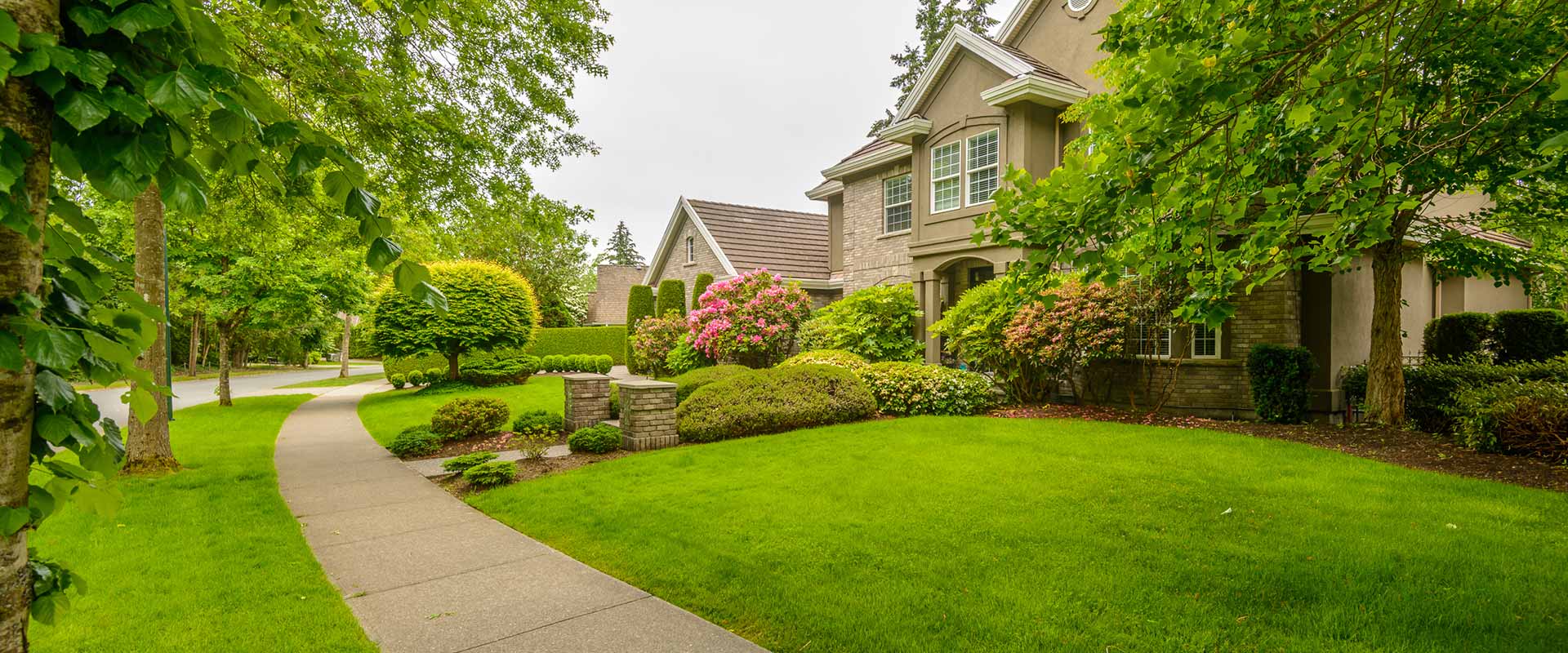Tree landscape tips are necessary in you want your turf, trees and woody plants to thrive. While all the living things in your landscape share some of the same needs, others are different. This post discusses beneficial practices to help them co-exist in your Seattle yard.
Tree & turf differences
Most landscaped areas include a combination grasses, trees, and plants that offer varying benefits to your yard. They also create problems for one another that need to be addressed.
- Thinning grass under large shade trees caused by lack of sunlight and/or water.
- Large tree roots are problematic when mowing.
- Trees damaged by lawn mowers or string trimmers when grass is close to tree trunks.
- Young trees suffer slow growth when grass competes with them for water and nutrients.
Shared environmental benefits
Your grass provides the same environmental benefits as trees so you should take care of both to ensure they flourish.
- Takes carbon dioxide and makes oxygen via photosynthesis.
- Cools air by changing water into water vapor.
- Filters dust, pollen, and other particles from the air.
- Entraps air-polluting gases.
- Reduces erosion and runoff.
Careful selection is needed
Most grasses are sun loving and don’t grow well in areas that get less than 50% open sunlight. That can be a challenge IF you have many large shade trees. Shade-tolerant grasses are available and may be the answer for shaded parts of your yard.
You may want to select woody plants that are smaller, have open canopies that let more sunlight filter through to the ground or have higher canopies. It’s also best to choose trees that don’t root near the surface, which is often the case with clay soils or shallow topsoil.
Competing for resources
Grass, trees, and plants all require and compete for sunlight, water, and rooting space for growth. In the fight for survival, certain plants release chemicals into the soil to prohibit the growth of nearby plants.
Leaving enough space between plants helps reduce competition for resources. When planting, you should keep in mind the size of the plant at full maturity. While it looks bare and that you’ve left too much space when first planted, it will quickly fill in as it grows bigger.
Turf & tree roots fight for nutrients
Roots fight for water, nutrients, and the space to grow underground. Did you know most of the water-absorbing little roots for grass and roots are in the top 6” of soil?
Grass roots take a bigger portion of the soil (compared to tree roots) and therefore, hog more of the water and nutrients. This is even more true if the tree was recently planted or younger.
If the tree is older and well-established, then grass root density is usually lower. This means resources tend to be more evenly split and tree roots get enough water, space, and nutrients to sustain growth.
Special care with new plantings
New plantings, whether trees or new sod, need to be given special treatment. Why? Because well-established trees and grass have a strong foothold in the area and are already taking up space for its root system.
The newest plantings need time to stake their claim and become established. To help newly planted trees, you should remove competing sod from around their trunk, so they aren’t competing for root space and nutrients. They should also be given more water to help them thrive.
Mulching is terrific option
Grass competes with trees and plants for water and nutrients which makes mulching a great alternative. A 2-to-4-inch layer around the trunk provides many benefits without any disadvantages.
- Retains soil moisture.
- Helps keep weeds and grass from growing.
- Protects trunk from injuries causing by lawn mowers and weed whackers.
- Improves soil biology and fertility as it decomposes.
Please note: Mulch should not touch the trunk. Start the mulch several inches from base of trunk to prevent decay.
Turf maintenance can cause problems
Trees and turf often occupy the same area, but they don’t have all the same requirements. This means maintenance treatments for your grass could have harmful effects on your trees.
For instance, herbicides can cause damage with misapplied. It can drift on windy days or vaporize on hot days damaging nearby woody plants. Most won’t kill tree roots but soil sterilants will so please read the label to avoid unintended consequences.
Fertilizers applied to one plant may also be absorbed by roots of nearby plants. While this can be a good thing, too much fertilizer can reduce disease and pest resistance or result in excessive aboveground growth.
Soil prep tip
Tree landscape tips wouldn’t be complete without mentioning to take care around existing trees when doing soil preparation before seeding. Disrupting the upper 4-6 inches of topsoil can cause damage to tree roots and hurt the tree’s canopy.
Follow our turf and tree landscape tips for your Seattle yard to be the envy of your neighborhood. Please contact Eastside Tree Works if you need tree services or to consult with one of our ISA Certified Arborists.

